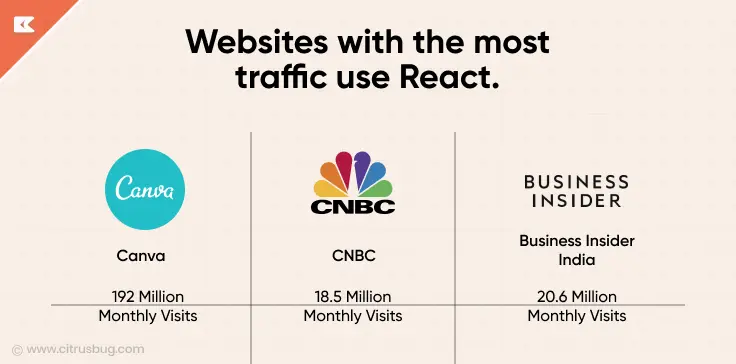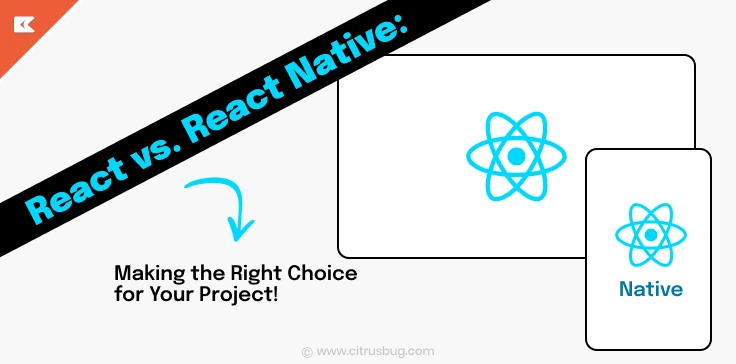React JS Statistics in 2025: Market Trends, Usage Data & Hourly Rates
- July 4, 2024
-
6227 Views
- by Ishan Vyas

React is a popular tool for building user interfaces on the web, and its use has grown a lot over the years. In 2025, many websites are using React to make their pages look and work great. This introduction will look at some key numbers and examples, including React statistics, that show just how important React has become. We’ll cover how many sites use it, how much React developers earn, and which industries and hosting providers are most likely to use React. We’ll also explore the role of a ReactJS development company in leveraging this technology for successful web projects. These insights will help you understand why React is such a big deal in web development today.
1)React Usage Statistics – 2025
In 2025, there are about 2 billion websites on the internet. Of these, more than 1.3 million use React to design their appearance and functionality for visitors. Compared to the previous year, React usage has increased significantly, with around 1,00,000 new websites adopting React to build their interfaces.
Top 3 Countries that use ReactJS
In the USA alone 3,685,454 live websites have chosen React for their front-end frameworks. This number highlights React’s strong presence and popularity among US-based websites.
A whopping 2,055,778 live websites in the UK alone have chosen React to build their user interfaces! This impressive number speaks volumes about React’s dominance and developer preference within the British market.
In Canada 632,026 all websites based in Canada use React for their front-end framework.
Source: (builtwith)
2) React Developer’s Wages Statistics
Average React Developer Salary
A Mid-level React Developer earns an annual salary of $139,830, while the income for Senior-level professionals stands at $184,973. In terms of hourly rates, Junior React Developers earn $60 per hour, whereas their mid, senior, and top-level counterparts receive $67, and $89 respectively.
ReactJS Developer Hourly Rates
- In the IT industry, the cost of the developers must be considered with the workload, project complexity, and proficiency to manage deadlines. As well as, a few general factors including location, type of project, and type of developers like freelancers and in-house developers.
As a renowned job portal, Indeed shows the salary of React js developers and it varies from the range between $90,000 to $110,000 annually in the USA.
Importantly, ReactJS Developer Hourly Rates in India range between $22 to $30 depending upon the experience of the developers.
Source: (builtwith)
3)Popular sites using React
Many popular, high-traffic websites rely on React for their front-end development. Among the top sites that utilize React are Facebook, Instagram, and Airbnb each known for their user-friendly interfaces.
Following closely behind are WordPress.com and Dropbox.com, which also leverage React to deliver seamless experiences to their users. Other notable websites using React include Netflix, WhatsApp Web and Discord.
These sites benefit from React’s powerful capabilities, enabling them to provide efficient, dynamic, and responsive user interfaces. This widespread adoption of React underscores its versatility and effectiveness in creating engaging web.
Source: (intelivita)
4) Industry verticals where ReactJS is being used
To compare the distribution of React JS usage across the specified industry verticals, let’s look at the percentages for each category. Here’s a breakdown:
Computers Electronics & Technology vs. Science & Education:
- React JS usage in Computers Electronics & Technology is slightly higher at 4.06% compared to 3.90% in Science & Education.
Games vs. Community & Society:
- The usage in the Games industry (2.44%) is marginally higher than in the Community & Society sector (2.32%).
Specific Verticals vs. Others:
- The “Others” category dominates the usage, with 87.29%, vastly surpassing any specific vertical. Each of the specified verticals holds a small fraction of the total, with none exceeding 5%.
Source: (similartech)
5) Websites with the most traffic use React
1. Canva
- Traffic: 192 Million Monthly Visits
- Description: Canva is an online design tool that lets users create graphics easily. It uses React JS to provide a smooth and responsive experience for its millions of users worldwide.
2. CNBC
- Traffic: 18.5 Million Monthly Visits
- Description: CNBC is a major business news website. It uses React JS to quickly update and display financial news and data, ensuring a fast and interactive user experience.
3. Business Insider India
- Traffic: 20.6 Million Monthly Visits
- Description: Business Insider India delivers business news and tech updates. The site uses React JS to offer a seamless reading experience, keeping its large audience engaged with up-to-date
Source: (builtwith)
6) Usage Stats of React broken down by web hosting providers
Amazon Web Services (AWS) holds a significant share of the cloud services market, powering 32% of it. This dominance reflects AWS’s wide array of services, making it a top choice for many businesses.
Among the numerous websites that utilise Amazon web hosting, a notable percentage incorporate public JavaScript libraries. Specifically, 1.7% of these websites leverage React, a popular JavaScript library for building user interfaces.
Source: (w3techs)
Conclusion
React will maintain its leading position in the list of front-end frameworks in 2025, and adoption is taking place globally and in many industries. Growing numbers of websites that use React for their user interfaces stand as a sign of increased reliability, efficiency, and preference by developers. As companies seek to leverage React’s capabilities, there will be a rising demand to hire ReactJS developers to build and enhance their web applications. This tendency will continue even further into the future, bringing React to ever-higher peaks of popularity and genuinely cementing its leadership in shaping the future of web development.





 SaaS Development
SaaS Development Web Application Development
Web Application Development Mobile Application Development
Mobile Application Development Custom Software Development
Custom Software Development Cloud Development
Cloud Development DevOps Development
DevOps Development MVP Development
MVP Development Digital Product Development
Digital Product Development Hire Python Developers
Hire Python Developers Hire Django Developers
Hire Django Developers Hire ReactJS Developers
Hire ReactJS Developers Hire AngularJS Developers
Hire AngularJS Developers Hire VueJS Developers
Hire VueJS Developers Hire Full Stack Developers
Hire Full Stack Developers Hire Back End Developers
Hire Back End Developers Hire Front End Developers
Hire Front End Developers AI Healthcare Software Development & Consulting
AI Healthcare Software Development & Consulting Healthcare App Development
Healthcare App Development EHR Software Development
EHR Software Development Healthcare AI Chatbot Development
Healthcare AI Chatbot Development Telemedicine App Development Company
Telemedicine App Development Company Medical Billing Software Development
Medical Billing Software Development Fitness App Development
Fitness App Development RPM Software Development
RPM Software Development Medicine Delivery App Development
Medicine Delivery App Development Medical Device Software Development
Medical Device Software Development Patient Engagement Software Solutions
Patient Engagement Software Solutions Mental Health App Development
Mental Health App Development Healthcare IT Consulting
Healthcare IT Consulting Healthcare CRM Software Development
Healthcare CRM Software Development Healthcare IT Managed Services
Healthcare IT Managed Services Healthcare Software Testing services
Healthcare Software Testing services Medical Practice Management Software
Medical Practice Management Software Outsourcing Healthcare IT Services
Outsourcing Healthcare IT Services IoT Solutions for Healthcare
IoT Solutions for Healthcare Medical Image Analysis Software Development Services
Medical Image Analysis Software Development Services Lending Software Development Services
Lending Software Development Services Payment Gateway Software Development
Payment Gateway Software Development Accounting Software Development
Accounting Software Development AI-Driven Banking App Development
AI-Driven Banking App Development Supply Chain Management Software Development
Supply Chain Management Software Development Fleet Management Software Development
Fleet Management Software Development Warehouse Management Software Development
Warehouse Management Software Development LMS Development
LMS Development Education App Development
Education App Development Inventory Management Software Development
Inventory Management Software Development Property Management Software Development
Property Management Software Development Real Estate CRM Software Development
Real Estate CRM Software Development Real Estate Document Management Software
Real Estate Document Management Software Construction App Development
Construction App Development Construction ERP Software Development
Construction ERP Software Development










